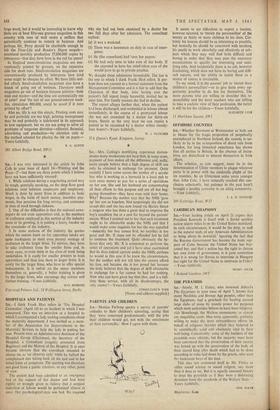Stn,—In his letter on magazine printing (April 21) Mr. Perry
implies that the demise of many trade papers derives from the lack of an economic print- ing process in this country. The tenor of this argu- ment appears to me to be mildly misleading; the facts however he advances in presenting the panacea of offset litho arc wildly wrong. There arc, he says, only two or three offset plants in England; I have just scribbled down seventeen in the margin of the Spectator without pause for thought and could double this figure at the drop of a pica.
What Mr. Perry probably had in mind in referring to rotary offset litho is the reel-fed offset litho process. The difference between printing from reels (this being the method by which Newsweek, Reader's Digest and The Lancet are produced) and from sheets (Knowledge and Men Only, in fact) is about similar from both a chronological and mechanical point of view to that between the Ford Model T and the latest Jaguar. If this is what he means, then he is correct in noting the present dearth of such machines in this country. However, he is certainly generalising up the wrong tree to claim that 'it is impossible to make a profit on a gravure run of under a million or, paradoxically, a letterpress run of more than about 250,000. . . .' Impossible is a large word; but it would be interesting to know why there are at least fifty-one gravure magazines in this country with runs of well under a million that quixotically continue to remain in business. And perhaps Mr. Perry should be charitable enough to telt the Time-Life and Reader's Digest moguls— combined monthly production 37,000,000 copies by letterpress—that they have been in the red for years?
In England mass-circulation magazines are con- ventionally printed by gravure, on the expensive side for short runs. Small-circulation magazines are conventionally produced by letterpress here (and, some might be cheaper by offset. We have little reel- fed offset). Small-circulation magazines also have a knack of going out of business. Therefore small magazines go out of business because printers—both man and master—and the time are economically out of joint? And 'the last of our general-interest week- lies, circulation 800,000, could be saved if it were printed by offset'?
Alas no, life is not this simple. Printing costs may be and probably are too high, printing management may be and probably is hidebound in its approach to new equipment, but we are not going to solve all problems of magazine direction—editorial, financial, advertising and production—by attention only to the method selected for placing the ink on paper.— Yours faithfully, 105 Albert Bridge Road, SW11
*
R. S. AUSTIN







































 Previous page
Previous page